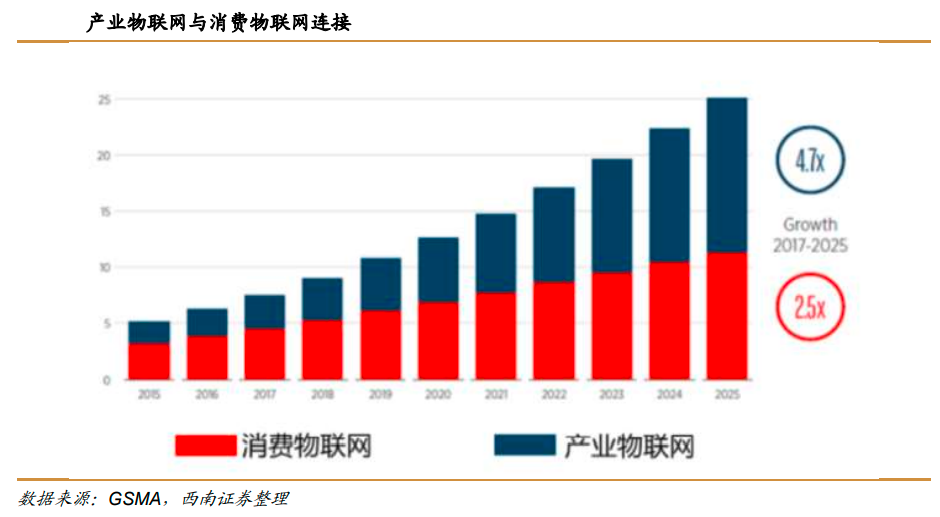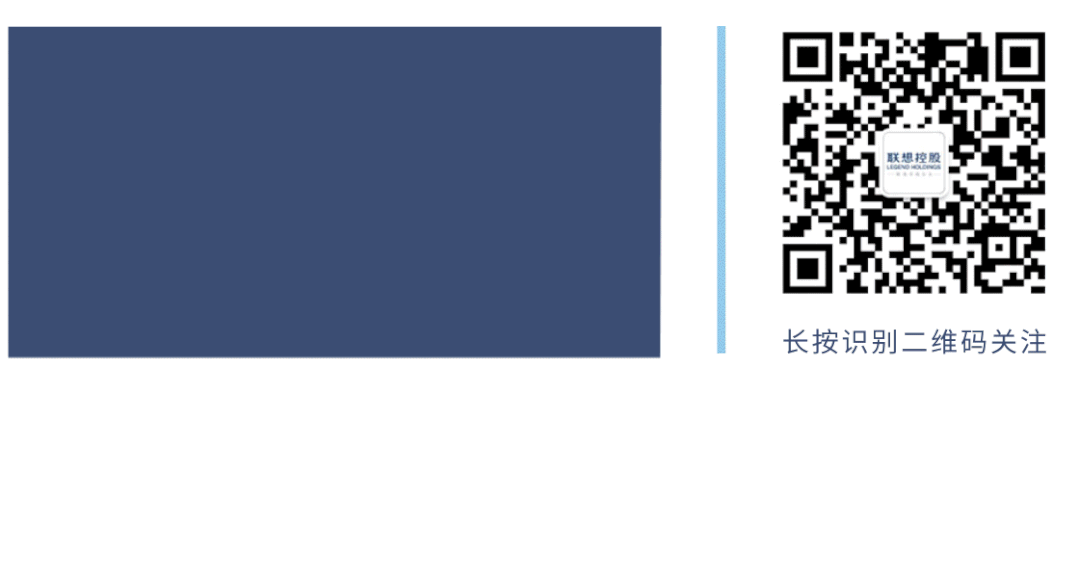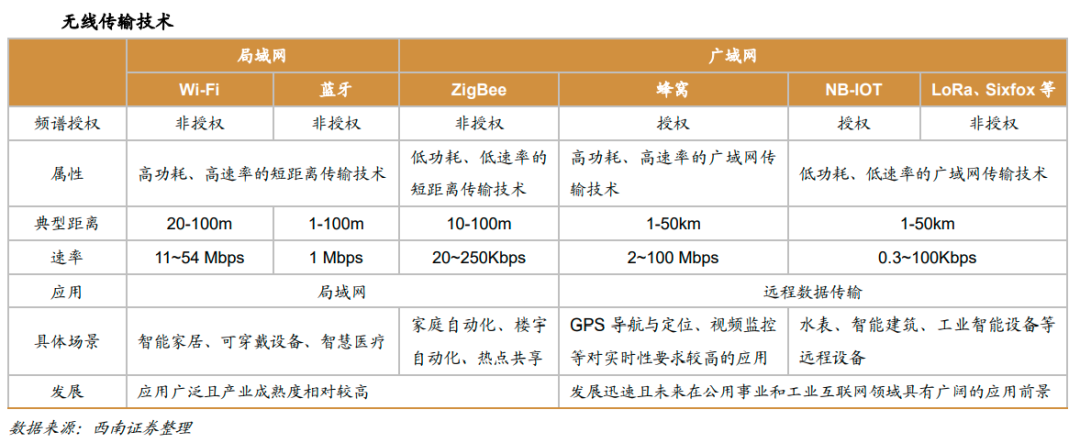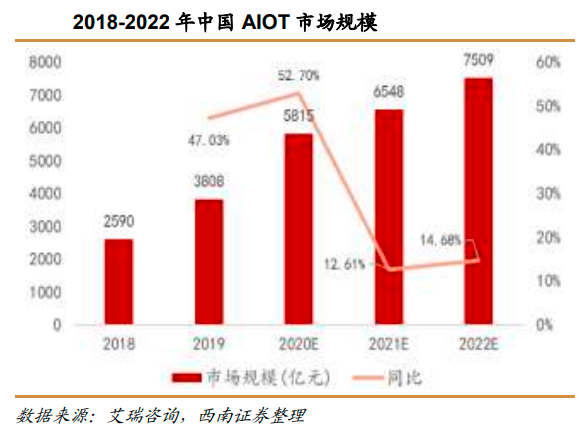

Smart speakers that converse with humans, smart lights that sense human presence, autonomous vacuum robots, and remotely controlled smart power strips… these consumer-grade IoT devices have already integrated into our lives. In addition, many IoT devices are being applied in various production scenarios such as industry and agriculture, including temperature and humidity sensors in the fields, cameras that identify fruit ripeness, and environmental detectors and logistics robots in factory workshops.
The increasingly common IoT devices are significantly enhancing the efficiency of social production and life. According to data from the China Industry Information Network, the number of IoT devices worldwide reached 10.7 billion in 2019, and it is expected to reach 25.1 billion by 2025, maintaining a growth rate of over 12% during this period. What key technologies underpin the various novel IoT products? From the perspective of the industrial chain, what new opportunities will emerge in the future? Below, enjoy~
01
 Four Levels, Insight into the IoT Industry Chain
Four Levels, Insight into the IoT Industry Chain
The Internet of Things (IoT) refers to the “internet that connects everything”. It connects objects to the internet for information exchange and communication through information sensing devices such as RFID (Radio Frequency Identification) and sensors, thereby achieving intelligent identification, positioning, tracking, monitoring, and management of objects.
As a technology-driven industry, the IoT is supported by a four-level architecture of sensing layer, transmission layer, platform layer, and application layer, where the upgrade and integration of technologies will directly drive market development. Among these, 5G technology, edge computing technology, and AIoT (Artificial Intelligence of Things) are gradually entering the IoT industry, accelerating its development pace.
|
Sensing Layer As the lowest layer of the IoT, it serves as the hub for physical sensing, primarily responsible for data collection. Data such as temperature, humidity, pressure (weight), atmospheric pressure (tire pressure), light intensity, gas composition, fingerprints, facial recognition, speed, and displacement can all be collected through sensors. |
|
|
Transmission Layer It acts as the pipeline of the IoT, primarily responsible for data transmission. IoT transmission is mainly wireless and can be divided into local area networks and wide area networks based on transmission distance. Local area networks mainly include short-range transmission technologies such as WiFi and Bluetooth, while wide area networks include technologies like ZigBee, cellular, NB-IoT, and Lora. 5G technology, as the latest generation of mobile communication technology, offers advantages such as high speed, low latency, high reliability, and large bandwidth, making it the core technology of the transmission layer.
|
|
Platform Layer In the IoT system, it plays a bridging role, primarily responsible for aggregating, processing, and analyzing data from the sensing layer, mainly including PaaS platforms, AI platforms, and other capability platforms. Among them, the integration of artificial intelligence (AI) and the Internet of Things (IoT) – AIoT, is expected to become one of the future development trends of the IoT. For example, Lenovo Group’s industrial IoT platform Leap IoT can not only achieve data collection, data preprocessing, and machine vision functions but also supports over 200 standard and proprietary industrial protocols, allowing it to interface with mainstream PLCs and CNC equipment to help enterprises achieve industrial data collection, edge computing, and real-time analysis.
|
|
|
Application Layer It is the top layer of the IoT, primarily solving specific industry problems based on data from the platform layer. According to users and application scenarios, it can be divided into smart travel, smart wearables, and other “consumer-driven applications”; smart security, smart energy, and other “policy-driven applications”; as well as smart industry, smart logistics, and other “industry-driven applications”. |
Currently, the IoT has begun to be applied in various fields such as home, public services, agriculture, logistics, services, manufacturing, and healthcare, with each sub-scenario possessing enormous development potential. Among them, Lenovo Group’s high-performance server product ThinkServer SE550 is suitable for many typical application scenarios:
|
Smart Community Can achieve indoor positioning, smart home, shopping districts; |
|
|
Smart Transportation Can achieve real-time traffic conditions, automatic navigation, congestion prediction; |
|
Smart Manufacturing Can achieve smart production, intelligent machines, smart factories; |
|
|
Smart City Can achieve video surveillance, smart streetlights, parking management, etc.; |
|
Others Additionally, smart supermarkets, smart construction sites, etc., also fall within the application scope of this edge server. |
02
 Future Trends:Demand-side Driven,Industrial IoT Scale ExplosionCurrently, the driving force behind the IoT market development is mainly supply-side, with communication services and hardware terminal revenue accounting for a high proportion. As supply-side technologies mature rapidly, the costs of hardware, data platforms, and AI algorithms have decreased, making the usage costs of IoT platforms no longer exorbitant, allowing demand-side consumers to achieve smarter applications within similar budget levels as before. At the same time, the energy of the demand-side market is becoming apparent, with increased large-scale applications. Smart homes, as the first market to enter large-scale applications in the IoT industry, have maintained growth in total shipments driven by the increase in home entertainment, home monitoring, and smart speaker hardware shipments. Additionally, the “policy-level application” market is growing rapidly, gradually becoming the main battleground for large-scale applications. For example, in the case of smart water meters, according to data from the Forward-looking Research Institute, the production of water meters in China was about 110 million units in 2019, of which smart water meters accounted for about 31 million units, with a penetration rate increasing from 17.6% in 2014 to 26.2%. According to the “5G Application ‘Set Sail’ Action Plan (2021-2023)” recently issued by the Ministry of Industry and Information Technology, the Central Cyberspace Administration, the National Development and Reform Commission, and other 10 departments, by 2023, the annual growth rate of 5G IoT terminal users is expected to exceed 200%.As the structure of IoT device connections changes, the scale of industrial IoT may experience a second explosion. Currently, based on mature technologies and a wide variety of products, consumer-grade IoT products have the largest audience and account for most of the current IoT connections. However, it is noteworthy that the IoT is at a turning point from quantity of connections to quality of data transformation, and only business applications based on large-scale data can realize the true value of the IoT. As the IoT penetrates various industries and the level of industry informatization continues to improve, the number of connections in industrial IoT is expected to surpass that of consumer IoT. According to GSMA Intelligence, one of the three major international organizations in the mobile communications industry, it is predicted that the number of industrial IoT connections will grow 4.7 times from 2017 to 2025, significantly higher than the 2.5 times growth expected for consumer IoT connections.
Future Trends:Demand-side Driven,Industrial IoT Scale ExplosionCurrently, the driving force behind the IoT market development is mainly supply-side, with communication services and hardware terminal revenue accounting for a high proportion. As supply-side technologies mature rapidly, the costs of hardware, data platforms, and AI algorithms have decreased, making the usage costs of IoT platforms no longer exorbitant, allowing demand-side consumers to achieve smarter applications within similar budget levels as before. At the same time, the energy of the demand-side market is becoming apparent, with increased large-scale applications. Smart homes, as the first market to enter large-scale applications in the IoT industry, have maintained growth in total shipments driven by the increase in home entertainment, home monitoring, and smart speaker hardware shipments. Additionally, the “policy-level application” market is growing rapidly, gradually becoming the main battleground for large-scale applications. For example, in the case of smart water meters, according to data from the Forward-looking Research Institute, the production of water meters in China was about 110 million units in 2019, of which smart water meters accounted for about 31 million units, with a penetration rate increasing from 17.6% in 2014 to 26.2%. According to the “5G Application ‘Set Sail’ Action Plan (2021-2023)” recently issued by the Ministry of Industry and Information Technology, the Central Cyberspace Administration, the National Development and Reform Commission, and other 10 departments, by 2023, the annual growth rate of 5G IoT terminal users is expected to exceed 200%.As the structure of IoT device connections changes, the scale of industrial IoT may experience a second explosion. Currently, based on mature technologies and a wide variety of products, consumer-grade IoT products have the largest audience and account for most of the current IoT connections. However, it is noteworthy that the IoT is at a turning point from quantity of connections to quality of data transformation, and only business applications based on large-scale data can realize the true value of the IoT. As the IoT penetrates various industries and the level of industry informatization continues to improve, the number of connections in industrial IoT is expected to surpass that of consumer IoT. According to GSMA Intelligence, one of the three major international organizations in the mobile communications industry, it is predicted that the number of industrial IoT connections will grow 4.7 times from 2017 to 2025, significantly higher than the 2.5 times growth expected for consumer IoT connections. At the moment of industrial explosion, the prospects for IoT development are broad. According to statistics from the China Industrial Development Research Institute, the scale of China’s IoT market reached 1.66 trillion yuan in 2020, and it is expected to further reach 2.12 trillion yuan by 2022. Additionally, according to global leading business data platform Statista, the global IoT market size reached 248 billion USD in 2020, and it is expected to exceed 1.5 trillion USD by 2025, with a compound annual growth rate of 44.59%.
At the moment of industrial explosion, the prospects for IoT development are broad. According to statistics from the China Industrial Development Research Institute, the scale of China’s IoT market reached 1.66 trillion yuan in 2020, and it is expected to further reach 2.12 trillion yuan by 2022. Additionally, according to global leading business data platform Statista, the global IoT market size reached 248 billion USD in 2020, and it is expected to exceed 1.5 trillion USD by 2025, with a compound annual growth rate of 44.59%.
References
> Southwest Securities: “Complete Overview of the IoT Industry Chain”> The most comprehensive IoT industry chain revealed, understanding the four levels and hundreds of players in one article
Previous Recommendations
(Swipe to read more)
Vision | Focus on the top ten trends in the vehicle networking industry, what kind of intelligent life will future cars bring?
Vision | Looking at the new round of technological revolution through 12 major technological trends
Vision | The digital wave is giving rise to ten new consumer opportunities
Vision | In the post-pandemic era, what health benefits do workers need?
Vision | How should enterprises seize personal IoT business opportunities?
Vision | Digital technology will explode in these 14 frontier application areas
Vision | From electronic medical records to artificial intelligence, the “Chinese model” of smart hospitals
Vision | Transportation is upgrading to digitalization, intelligence, and interconnectivity
Vision | Over 70% of consumers view snacks as “spiritual food”
Vision | Internet healthcare has entered the 3.0 era, with a trillion market scale waiting to be unlocked
Vision | The development and opportunities of AI + finance in China
Vision | AI is helping the rapid development of “smart logistics”
Vision | Online music performances are welcoming a prosperous starting point
Vision | The “cooking art” in the post-smart kitchen era
Vision | The rise of “short video + education”, will your learning be changed?
Vision | The pet economy is also crazy
Vision | China’s advantages in the era of service robots
Vision | The advancing Chinese satellite internet
Vision | Boston Consulting: New trends in the global asset management industry under the pandemic
Vision | The “medical imaging” from the physical era to the intelligent era
Vision | Bosses who can’t live stream won’t become good internet celebrities
Vision | The new ecosystem of industrial payment with a scale of trillions
Vision | The new business brought by intelligent voice technology
Vision | Five major trends in the digitalization process of enterprises
Vision | The 95 post-90s generation driving a trillion “new consumption”
Vision | Understanding the two-dimensional world around you! Ten answers about the Chinese two-dimensional group
Vision | The rise of rational consumption, activating the second-hand market
Vision | The “night economy” that makes people forget to sleep and eat
Vision | The lottery that tortures you a thousand times, you still wait for it like your first love
Vision | Food is the primary need, is there still a chance for the restaurant industry in 2019?
Vision | Secretly telling you which fruits have not increased in price

THE END


